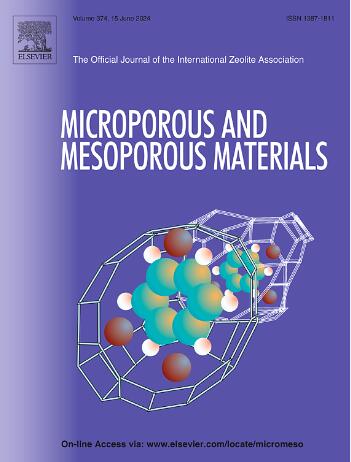Investigation on the residual dehydration capacities of aged industrial LTA molecular sieves
IF 4.7
3区 材料科学
Q1 CHEMISTRY, APPLIED
引用次数: 0
Abstract
Dehydration over industrial zeolite adsorbents is essential for significantly reducing water traces in natural gas. During this process, where large quantities of these materials are used, aging occurs over time. This study examines these aged adsorbents taken at three different levels of the drying column height to evaluate their residual performances compared to the fresh adsorbent. XRF, CHNO, and DRX analyses are performed to assess the composition and crystallinity of these adsorbents. The textural properties are determined using a volumetric surface analyzer with N2 and Ar at −196 °C and CO2 at 25 °C. Finally, adsorption−desorption isotherms of H2O vapor are measured via a dynamic gravimetric adsorber.
All the measured parameters (structural and textural) decrease in the following order: fresh 4A > top > bottom > middle. Based on the H2O adsorption capacity at equilibrium, the performance losses are 51.39, 18.82, and 10.95 % for the middle, top, and bottom adsorbents, respectively. In addition, according to the H2O TPD profiles obtained via gravimetry, activation energies (Ea) are determined using both isoconversional model-free methods (FWO, KAS, and Starink) and peak methods (Ozawa, Kissinger, and Starink). Regarding the evolution of Ea versus conversion, the results show that the isoconversional method appears inconclusive. In contrast, the peak method demonstrates perfect coherence with the evolution of structural and textural properties. An oxidative heat-treatment at 500 °C shows an appreciable improvement in both capacity and rate of adsorption.

老化工业LTA分子筛剩余脱水能力的研究
工业沸石吸附剂的脱水对于显著减少天然气中的水痕迹至关重要。在这个过程中,大量使用这些材料,随着时间的推移会发生老化。本研究考察了这些老化的吸附剂采取在三个不同水平的干燥柱高度,以评估其残余性能相比,新鲜吸附剂。XRF、CHNO和DRX分析被用来评估这些吸附剂的组成和结晶度。使用体积表面分析仪测定其织构性能,N2和Ar温度为- 196°C, CO2温度为25°C。最后,通过动态重量吸附器测量了水蒸汽的吸附-解吸等温线。所有测量参数(结构和织构)的下降顺序如下:新鲜4A >;最高的在底在中间。以平衡状态下的水吸附量为基准,中、上、下吸附剂的性能损失分别为51.39%、18.82%和10.95%。此外,根据通过重力法获得的H2O TPD剖面,使用无等转换模型法(two, KAS和Starink)和峰法(Ozawa, Kissinger和Starink)确定活化能(Ea)。对于Ea与转换的演化,结果表明等转换方法不具有决定性。相反,峰值法与结构和织构性能的演变具有很好的一致性。在500℃下进行氧化热处理,在吸附能力和吸附速率上都有明显的改善。
本文章由计算机程序翻译,如有差异,请以英文原文为准。
求助全文
约1分钟内获得全文
求助全文
来源期刊

Microporous and Mesoporous Materials
化学-材料科学:综合
CiteScore
10.70
自引率
5.80%
发文量
649
审稿时长
26 days
期刊介绍:
Microporous and Mesoporous Materials covers novel and significant aspects of porous solids classified as either microporous (pore size up to 2 nm) or mesoporous (pore size 2 to 50 nm). The porosity should have a specific impact on the material properties or application. Typical examples are zeolites and zeolite-like materials, pillared materials, clathrasils and clathrates, carbon molecular sieves, ordered mesoporous materials, organic/inorganic porous hybrid materials, or porous metal oxides. Both natural and synthetic porous materials are within the scope of the journal.
Topics which are particularly of interest include:
All aspects of natural microporous and mesoporous solids
The synthesis of crystalline or amorphous porous materials
The physico-chemical characterization of microporous and mesoporous solids, especially spectroscopic and microscopic
The modification of microporous and mesoporous solids, for example by ion exchange or solid-state reactions
All topics related to diffusion of mobile species in the pores of microporous and mesoporous materials
Adsorption (and other separation techniques) using microporous or mesoporous adsorbents
Catalysis by microporous and mesoporous materials
Host/guest interactions
Theoretical chemistry and modelling of host/guest interactions
All topics related to the application of microporous and mesoporous materials in industrial catalysis, separation technology, environmental protection, electrochemistry, membranes, sensors, optical devices, etc.
 求助内容:
求助内容: 应助结果提醒方式:
应助结果提醒方式:


